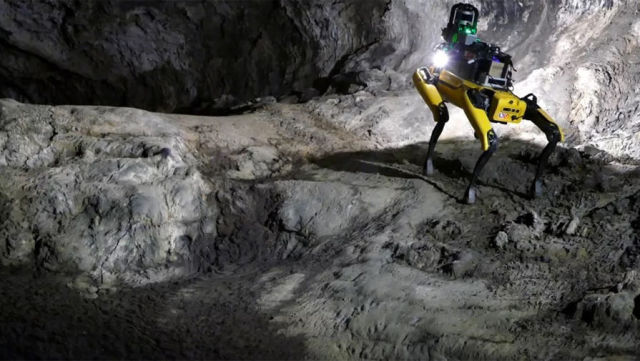Robot dogs to help scientists explore Martian caves
Scientists have proposed to explore the Martian caves with robotic "dogs". Without fear of getting lost or stuck, they will be able to significantly expand the possibilities of missions on the surface of the planet.
In the Martian missions of the future, full-size rovers can be supplanted by dogs. True, not alive, but robotic, able to penetrate into places where the wheel will not pass any Rover.
Scientists working on the four-legged robot have equipped it with artificial intelligence, and a whole set of sensitive sensors that will allow it to autonomously navigate difficult terrain and in caves under the surface of the planet.
The new method of studying Mars was reported on the eve of the annual meeting of the American Geophysical Union, which takes place online. The concept was presented by scientists from the Jet Propulsion Laboratory and the California University of Technology, telling why the Martian "dogs" are able to maneuver so skillfully as none of the previously launched rovers - Spirit, Opportunity, Curiosity and Perseverance.
traditional rovers are designed to move mainly on a flat surface, but to reach many interesting places from a scientific point of view, it is necessary to overcome quite difficult obstacles or even fall below the surface level. the proposed robots are ideal for such tasks - even if they fall, they can easily rise.
According to calculations, robot dogs will be about 12 times lighter than modern rovers, and will be able to move much faster, reaching speeds of 5 km / h, shown in the tests. For example, the Curiosity rover currently operating on the surface of Mars is moving at an average speed of 0.14 km/h.
Of particular interest for future Martian missions are natural caves, which in the future will be able to serve as a natural refuge for humans. They will be able to shelter colonists from such dangerous factors as harmful ultraviolet radiation, low temperatures and strong dust storms. Such storms can last for months and even be noticeable for observations from Earth.
Caves can store traces of life that flourished in the distant past, or even be a refuge for organisms that live on the planet and in our time under the surface of the planet.
the proposed robot, which was given the name au-spot, is an improved version of the spot robot, a four-legged robot of the famous company boston dynamics. More than 60 people are working on the development of Martian dogs.
The Au-Spot robot processes data from laser lidar, visual, infrared information and data from motion sensors to create three-dimensional maps. It is also able to use artificial intelligence to learn which places to avoid and how to explore objects of scientific interest.
At the same time, a special communication module allows you to transmit data to the surface when the robot is underground. The team has already conducted numerous tests of the robot, forcing it to climb and descend stairs, in landscapes resembling Martian ones, as well as in the lava tubes of Northern California.
"The robot's behavior could one day revolutionize scientific missions on and below the Martian surface, expanding NASA's capabilities to explore traditionally unattainable areas," the scientists said, according to Livescience.
Last summer, Italian scientists from the Universities of Padua and Bologna suggested the presence of giant caves on the Moon and Mars, in which in the future settlers from Earth could live. these are so-called lava tubes formed by lava flows during volcanic eruptions.
"we can find lava tubes on earth, but also under the surface of the moon and mars, according to high-resolution images taken by interplanetary probes. the presence of lava tubes was implied by the observation of linear cavities and winding chains of collapses, with collapsed galleries, " explained the author of the study, francesco sauro.
"We measured the size and morphology of lunar and Martian collapsed chains using digital terrain models obtained from stereoscopic images and laser altimetry from interplanetary probes. We then compared this data with topographical studies of similar chains on the Earth's surface and laser scanning data from the lava tubes of Lanzarote and the Galapagos Islands, " explained co-author Ricardo Pozzobon.
Based on comparisons, scientists have concluded that Martian and lunar tubes can be 100-1000 times more voluminous and long than those found on Earth. "Tubes of this width can be over 40 kilometers long, making the moon an excellent target for subsurface exploration and possible settlements," Pozzobon added.
Nikolai Gorodetsky

